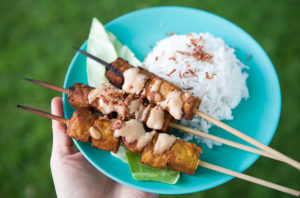Christmas in New Zealand is less about snow and sleigh bells and more about sun, sand and barbecues in the backyard. This is perfect time to enjoy a barbecue with family and friends. Can not wait for picnic with festive delicious food and fabulous local bubbly wine. I know, my friends, it is difficult to enjoy the barbecue if you do not eat meat, in this case I have prepared for you this fancy recipe tempeh satay. Tempeh satay is very popular dish in Indonesian cuisine. I tried to make the recipe authentic as possible and affordable at the same time. Below you can find information about the ingredients and where to find them.
Hungry yet?


Tempeh is product from soybeans cooked and fermented with special culture. It has a firm chewy texture and a light nutty mushroom flavor. Tempeh is a nutritional super hero. It is high in protein, dietary fiber, iron, potassium and calcium.

Uncooked tempeh has almost no taste, but has an excellent texture and a high absorbency. It absorbs flavors even more readily than tofu does!
Tempeh is a traditional product originating from Indonesia. Indonesian cuisine makes from tempeh absolutely amazing dish. What is the secret? The secret is in the marinade! The tempeh necessary to marinate in a rich spicy sauce, and then evaporate a liquid. Get cooking with this flavorful recipe!
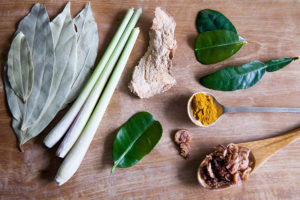
Clockwise from top left:
Indian Bay Leaves
Lemongrass
Dried Galangal
Kaffir Lime Leaves
Turmeric Powder
Crispy Fried Shallots
Bay leaf. Asian bay leaves are not the same as Western bay leaves. Indonesian bay leaf is strongly aromatic and has name Daun Salaam. I use Indian bay leaf in my recipe, it`s very similar and easy to find it in Indian grocery stores.
Fresh lemon grass, galangal, kaffir lime leaf are the most popular herbs in Indonesian cuisine.
Lemongrass, Citronella grass or Serai is a stalky plant with a lemony scent that grows in many tropical climates, most notably in Southeast-Asia. A common ingredient in Thai and Indonesian cooking, lemongrass provides a zesty lemon flavor and aroma to many dishes. To use lemongrass in marinades, stir-fries, salads, spice rubs, and curry pastes. Only the white part of the lemongrass stem is edible.
It is difficult to find fresh lemongrass in New Zealand and as well as quiet expensive. But It’s easy to find the package of frozen lemongrass for good price in supermarkets and Asian stores. So look for it in the Pak’n’Save frozen vegetables department.
Galangal is a root from the ginger family. It is widely used in South-East Asian cuisine. I have not found a fresh Galangal, so I bought dried. It has a very rich taste, I like it.
Kaffir lime leaves (Daun Jeruk Purut in Indonesia), these are the fragrant leaves of the wild lime tree and are used widely in Indonesia, Thai and South East Asian cuisine in the same way as bay leaves are used in the West. They have a spicy, lemony flavour and give a distinctive citrus scent to soups and curries. Kaffir lime leaves is important ingredient in Tom Yam soup, Rendang, Bubur Ayam, Urab. I usually keep a kaffir lime leaf in the freezer, that it is available at any time.
Turmeric comes from the root of the Curcuma longa plant and has a tough brown skin and a deep orange flesh. Turmeric has long been used as a powerful anti-inflammatory in both the Chinese and Indian systems of medicine. Turmeric is one of Indonesian cuisine’s major ingredients. Both in It`s fresh root and powdered form.
Crispy Fried Shallots. Finely sliced, deep-fried shallots are used as a condiment in Asian cuisine. I usually buy it in an Asian store and keep in an airtight container.
If you are a big fan of Asian food, spices and vegetables, I recommend you to visit the Avondale market is a real piece of Asia which is located in Auckland.
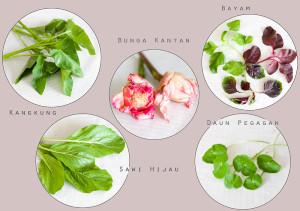 Do not miss my Asian Guides with fruits, vegetables and herbs that I created especially for Asian food lovers like me.
Do not miss my Asian Guides with fruits, vegetables and herbs that I created especially for Asian food lovers like me.
Ingredients
For Tempeh Skewers2 Serves
- 250g Organic Tempeh, cut into cubes
- 1/2 Can of Coconut milk
- 1 Stem of Lemongrass, white part only, crushed and finely chopped
- 1 Piece of dried Galangal root
- 3 Asian Bay leaves
- 1Tsp Turmeric powder
- 1Tsp Coriander powder
- Piece of fresh chili, chopped (or pinch of chili powder)
- 1 Tbsp garlic paste (grated garlic)
- 1 Tbsp Ginger paste (grated ginger)
- Salt
+ 8 (20cm) Bamboo Skewers
Directions
Heat coconut milk in sauce pan on low medium heat. When it’s hot, turn off the heat, add all remaining ingredients and mix well. Carefully lay tempeh into spicy coconut milk and gently mix. Marinate for a three hours or overnight in the fridge.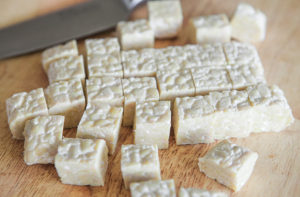
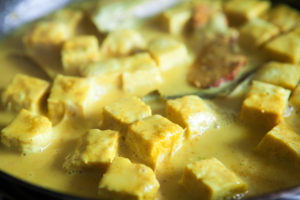
Bring to boil marinated tempeh on medium-high heat and cook until almost all liquid has evaporated. Remove from heat and chill slightly.
Thread tempeh onto each of 8 skewers.
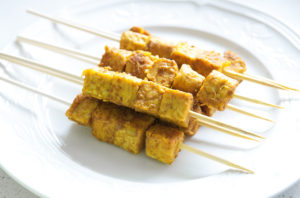
Place skewers on grill; grill 10 minutes or until browned.
Tip:
If you do not have a grill, use oven. Place the skewers on the lined with paper baking tray and bake at 200 ° C until golden brown. Do not overdo skewers, or tempeh can be too dry.

Ingredients
For Peanut Sauce- 250g Natural Peanut butter (unsweetened)
- 3 Shallots onion or one medium size onion
- 4 Garlic cloves
- 50g Coconut sugar
- 4 Kaffir lime leaves
- 1 Tsp grated ginger (or Kaempferia galanga, if you have it)
- 1 Tbsp melted coconut oil
- 2 Cups hot water
- Fresh chili, optional
- Salt
- Black pepper
For Garnish:
- 2 Cups steamed medium grain rice (optional)
- Crispy fried shallots
- Cabbage leaves
- Indonesian chili sauce Sweet Sambal (optional)
- Kecap Manis, famous Indonesian sweet soya sauce (available in Pak`n`Save)
Directions
- Mix garlic, onion, chili, ginger and coconut oil in the food processor till paste.
- Heat a large nonstick frying pan over low medium heat. When it’s hot, add spicy paste and cook until onion is translucent, about 3 minutes.
- Add peanut butter, 2 cups of hot water, kaffir lime leaves, palm sugar, salt and pepper. Boil the sauce over low heat until it thickens. Add more water by tablespoonfuls if needed to thin.
- Remove kaffir lime leaves. For a very smooth texture use the stick blender and blitz it for a few minutes.
- Keep in fridge up to 3 days.
Place the tempe skewers on fresh cabbage leaves, garnish with rice, drizzle with plenty of peanut sauce and sweet soy sauce Kecap Manis, sprinkle with crispy fried shallot.
Enjoy!
